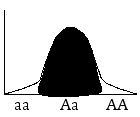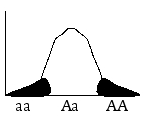Three types of selection are "directional selection," "balancing selection," and "selection against heterozygotes."
a)Shown below are three graphs (A-C).Each graph represents a different type of selection.In each case,certain individuals are being selected against (represented by the striped regions).For each graph,write the name of the type of selection that is depicted.
A)
B)
C)
b)Described below are three examples of selection.For each example,write the name of the type of selection being described.
i)A maize breeder selects for increased ear size in maize in order to increase yield.
ii)Susceptibility to malaria and sickle-cell anemia is controlled by the same gene.The HbA allele provides resistance to sickle-cell anemia but not to malaria (thus,individuals who have the genotype HbAHbA die from malaria),and the HbS allele provides resistance to malaria but not to sickle-cell anemia (thus,individuals with the genotype HbSHbS die from sickle-cell anemia).HbAHbS individuals are resistant to both diseases.
iii)Lower-yielding beans are resistant to anthracnose,whereas higher-yielding varieties are susceptible to the disease.Anthracnose is present only in certain areas of the region.So,breeders want to select higher- and lower-yielding plants to fulfill different breeding goals.
Definitions:
Biological Perspective
An approach in psychology focusing on the physical and biological bases of behavior.
Brain Chemistry
The complex interplay of neurotransmitters, hormones, and other chemicals in the brain, affecting mood, behavior, and cognitive function.
Evolutionary Psychology
Evolutionary psychology examines how evolutionary principles such as natural selection have shaped the development of human behavior and mental processes.
Visual-Spatial Task
A task that requires individuals to use their visual perception and spatial judgment to solve problems or navigate the environment.
Q24: The time value of money concept works
Q25: Which of the following about the Sanger
Q33: The cDNA for a eukaryotic gene B
Q37: The phenomenon in D.melanogaster known as Position-Effect
Q37: A linear DNA molecule has n target
Q64: A company is considering purchasing a machine
Q93: Which methods of evaluating a capital investment
Q112: Under which of the following conditions is
Q115: Fixed budgets are also known as flexible
Q126: Saxon Manufacturing is considering purchasing two